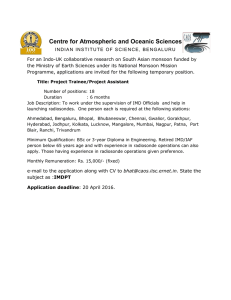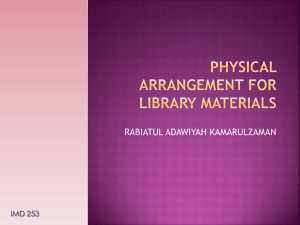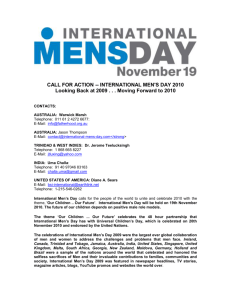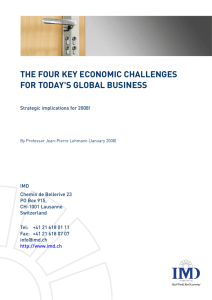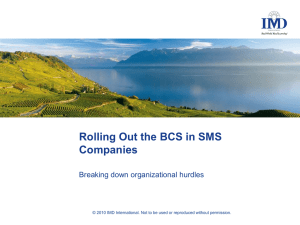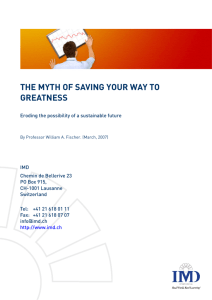Press Release Materialdesign_kk_EN
advertisement
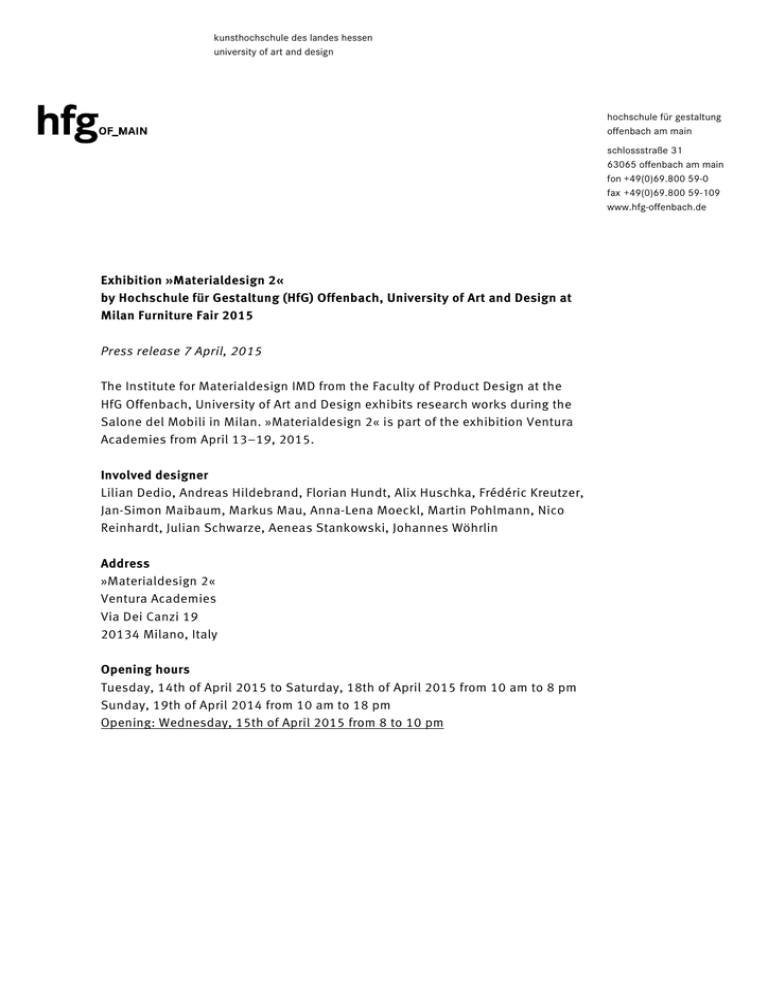
kunsthochschule des landes hessen university of art and design hochschule für gestaltung offenbach am main schlossstraße 31 63065 offenbach am main fon +49(0)69.800 59-0 fax +49(0)69.800 59-109 www.hfg-offenbach.de Exhibition »Materialdesign 2« by Hochschule für Gestaltung (HfG) Offenbach, University of Art and Design at Milan Furniture Fair 2015 Press release 7 April, 2015 The Institute for Materialdesign IMD from the Faculty of Product Design at the HfG Offenbach, University of Art and Design exhibits research works during the Salone del Mobili in Milan. »Materialdesign 2« is part of the exhibition Ventura Academies from April 13–19, 2015. Involved designer Lilian Dedio, Andreas Hildebrand, Florian Hundt, Alix Huschka, Frédéric Kreutzer, Jan-Simon Maibaum, Markus Mau, Anna-Lena Moeckl, Martin Pohlmann, Nico Reinhardt, Julian Schwarze, Aeneas Stankowski, Johannes Wöhrlin Address »Materialdesign 2« Ventura Academies Via Dei Canzi 19 20134 Milano, Italy Opening hours Tuesday, 14th of April 2015 to Saturday, 18th of April 2015 from 10 am to 8 pm Sunday, 19th of April 2014 from 10 am to 18 pm Opening: Wednesday, 15th of April 2015 from 8 to 10 pm kunsthochschule des landes hessen university of art and design Analog and digital design processes combining material and structure The Institute for Materialdesign IMD understands itself as a hub for inspiration – analog and digital methods are combined to create cross-material innovations. Ideas are frequently generated through the characteristics of the material itself, its qualities and its possibilities as well as its limits. Through the speculative combination of materials, transferring traditional processes of fabrication into innovative contexts, surprising results are achieved. Implementing randomization into the research establishes various remarkable starting points for the design process. The experimental approach and freedom of creative research is a characteristic of the IMD's approach to teaching. Here, researchdriven projects stand alongside object-related product design. Many of the works exhibited address the relation between man and material. The extended understanding of the material shifts toward the role of the actual object. This new role of materials also comprises the intersection of nature and artifact. Materials are brought to life through layering and combining natural and synthetic elements and blending in digital techniques. The borders of perception are erased and the material itself is redefined. Designing with materials creates a new context between art and science. Material-centred design opens up the field of design to new possibilities and creates a broad space of conceivable tasks. Prof. Dr. Markus Holzbach teaches Visualization and Materialization at the Faculty of Product Design at the University of Art and Design Offenbach. The recently founded Institute for Materialdesign IMD creates a platform for interdisciplinary dialog and experimental research as an innovative approach to teaching. Contact: Katja Kupfer, presse@hfg-offenbach.de, +49-69-800 59-156 (office) Ulrike Grünewald, transfer@hfg-offenbach.de, +49-178-4682740 (mobile) Photo download: http://www.hfg-offenbach.de/de/pages/pressestelle?type=press#downloadbereich 2 kunsthochschule des landes hessen university of art and design Materialdesign 2 – Selected Works »Intuitive Brain – Materials to Implement Future Interaction« Project in cooperation with BMW AG Functional surfaces are reinterpreted as an aesthetic medium of communication and of information. How can materials and experimental research help to achieve more tangible and intuitive interfaces? Through combining creative and scientific research with human centred design new functionalities are created. The main priority was to layer physical materialities and interaction. Experimental series, material patterns as well as physical and digital processing lead to a broad variety of projects. Interactive mock-ups where developed to enhance feasibility and perception. Supervision Prof. Dr.-Ing. Markus Holzbach, IMD Prof. Georg-Christof Bertsch, Intercultural Design Dipl.-Des. Steffen Reiter, IMD Dipl.-Des. Friedrich Söllner, IMD Transformative Paper Florian Hundt 3 kunsthochschule des landes hessen university of art and design The anisotropic material properties of moisture expansion in industrially produced paper and natural wood are similar and mostly tried to be avoided. Combined with other materials though, the expansion of the paper reveals interesting effects, which can be used in rather atypical contexts. My project is a layered structure, which reacts to short-term environmental conditions, morphing into various states. Thoroughly dry, it creates a tactile and exciting surface by raising the separate segments. Exposed to minimal change of humidity it creates a gesture so subtle it is almost invisible, while it performs a vast transformation when it gets wet. Under the influence of rain the layers shape a closed surface and respond by glowing gently. Magnetic Fabrics Dipl.-Des. Lilian Dedio The goal of this work was to explore new limits of fabrics, to experimentally further develop familiar features of them through unexpected modifications. To create these modifications different aspects of magnetism are incorporated into traditional fabrics. The combination of methodically arranged magnetically active and passive components causes a mechanical accumulation of elements and thus a dynamic rearrangement of the entire medium. Over and above the original intention to set the fabric in motion, a surprising set of innovative aesthetics was achieved. The work illustrates the relationship between media and shape by unique motion sequences. 4 kunsthochschule des landes hessen university of art and design Project »Forschungspavillon« Dipl.-Des. Nico Reinhardt Ph. D. student/Doktorand am Lehrgebiet Visualization and Materialization Supervision Prof. Dr.-Ing. Markus Holzbach, IMD The pavilion consisting of six thin shell elements is the result of a research project. The material-centred design process can be seen as an exemplary contribution to design science. The central question lies within materiality as starting-point of a design process. At first the materials of research are picked and analysed to determine the characteristic properties. Then digital as well as analog technologies of processing are brought into consideration to shape the material into a surface. Here, various prototypes are created to serve as an inspiration to the product design process. In this particular case a textile surface is analysed and layered with an anorganic matrix. The material study leads into the invention of a new fiber-reinforced composite-structure. 5
